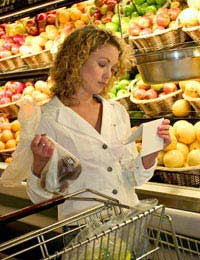Tips to Deal with a Gluten Free Life: Go Shopping

A person who has been diagnosed with a gluten allergy or suspects they may suffer from one needs to begin a new diet in which all foods containing gluten are completely eliminated. This picky and limiting diet can be a frustration but it is a small piece to pay in comparison to suffering from a chronic illness.
Going Shopping
A gluten allergy sufferer will initially find their food shopping trips taking a lot longer than they used to as they will have to become a keen student of food labels. The key is to develop a habit of buying gluten free products and foods so that it becomes second nature. This has become far easier in recent years due to an increased awareness of the problem.Many products now state clearly on the packaging if they are gluten free. Certain types of foods that are ordinarily rich in gluten, such as pasta, now have gluten free options. This is due to the fact that food companies are now aware that as more people are diagnosed as having a gluten allergy the market will continue to grow. To supply this demand there is an increasingly wider range of gluten free products on the shelves.
Wheat, barley and rye are the main offenders for those with a gluten allergy so they should start by taking them off the menu. Then avoid the following whilst food shopping: most flours, cereals, bread and starches, plus malt, vegetable gum, emulsifiers, vegetable protein and hydrolysed vegetable protein.
Finding Alternatives
Some of the aforementioned list are common in many foods and can be difficult to steer clear of but there are gluten free alternatives available. When purchasing flour go for soybean or tapioca flour. With starches, the only option is cornstarch. Breakfast cereals containing only rice, corn, hominy or oats. The latter is acceptable to some but not all sufferers and it may be safest to eliminate them anyway. Any breads and baked goods must be made using alternative ingredients such as rice, soy, tapioca, arrowroot and potato. When eating out avoid gravy plus any breaded and creamed foods.Foods that are safest when undertaking a gluten free diet include: rice, potatoes, fruit, beans, corn and buckwheat. In restaurants plump for broiled or roasted meats such as beef, poultry or fish with plain vegetables and salads.To make life easier it is highly recommended to buy at least one of the numerous cookbooks containing a range of gluten free recipes. There is also a huge amount of information and recipes to be found on the Internet.
Although a gluten free diet is not easy to stick rigidly to there are other fringe benefits as well as the obvious allergy symptoms avoidance. An added incentive of a gluten free diet is that it is a healthy option as a sufferer can focus on fruit and vegetables rather than fatty foods. Finally mundane food shopping can now become a more involving task as the patient can benefit from some classic retail therapy.
- Planning a Hospital Stay If You're Gluten Free
- Gluten Free Drinks For Grown Ups
- The Best Holidays for Gluten Free Fun
- Dieting and Gluten Intolerance
- Planning a Gluten Free Wedding
- Working With Your Dietitian to Stay Gluten Free
- A Gluten Free Pregnancy
- Weaning Your Baby If You Are Gluten Intolerant
- Stress Free Gluten Free Holidays
- Prescription Foods for Gluten Intolerance
- Cross Contamination and How to Avoid It
- Gluten Free Fitness
- Living Gluten Free as a Student
- Gluten Free Diets and Dining Out
- Children and Gluten Intolerance
- Travelling Abroad With Gluten Intolerance
- Get a More Healthy Lifestyle with a Gluten Intolerance
- Learn to Cook to Help with a Gluten Allergy
- Joining a Forum or Support Group for Gluten Allergies
- Allergy Support from Family or Friends
- Speaking to Your Doctor About a Gluten Allergy


Re: What Tests Check for Gluten Allergy?
I was having loads of smelly wind, loads of smelly diarrhea, stomach pain, bloating. I researched and came to the…
Re: Soda Crackers Recipe
Hi, I've been looking for a gluten-free soda cracker recipe to use in those refrigerator desserts where you layer the crackers with pudding…
Re: Coping With Gluten Free Life: Case Study
Has anyone had sudden onset insomnia on the GFD? Ten weeks in I suddenly stopped sleeping properly. Any advice or…
Re: Does Gluten Intolerance Ever Go Away on its Own?
I've been following a fodmap diet for nearly 2 years and I'm under a fodmap specialist. I am now…
Re: Coping With Gluten Free Life: Case Study
ruthmarian - Your Question:I am one week into a gluten free diet. I feel awful. Achy, headaches, flu-like symptoms.…
Re: Coping With Gluten Free Life: Case Study
I am one week into a gluten free diet. I feel awful. Achy, headaches, flu-like symptoms. I am hoping it will lead…
Re: Gluten Free Summer Pudding Recipe
cook - Your Question:The illustration for this dessert bears no resemblance to the method, that is, tearing the bread into…
Re: Gluten Free Summer Pudding Recipe
The illustration for this dessert bears no resemblance to the method, that is, tearing the bread into little pieces and…
Re: Coping With Gluten Free Life: Case Study
Would you be able to tell me can gluetan make you depressed if you are prone to depression
Re: Gluten Free Apple Pie Recipe
Your site is excellent. I'm a chef & run a restaurant at a sheltered housing complex for elder people. I have two people on a…